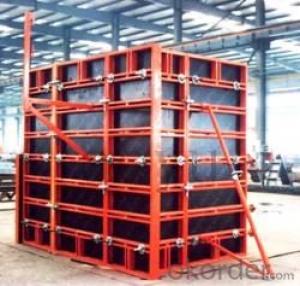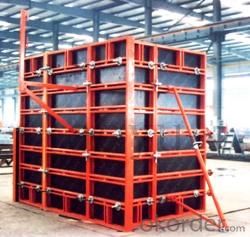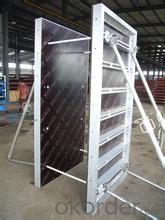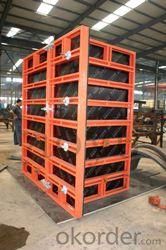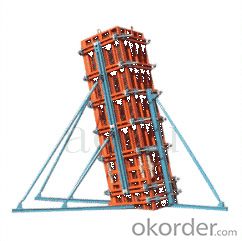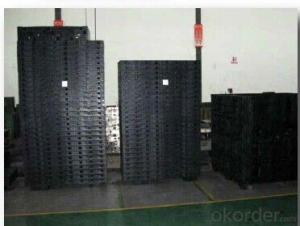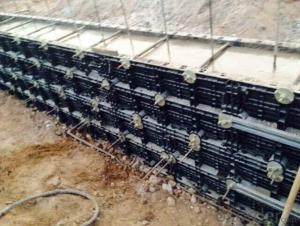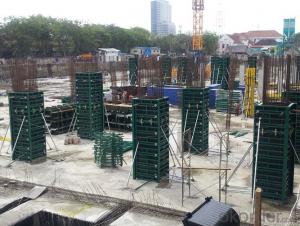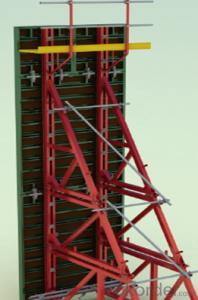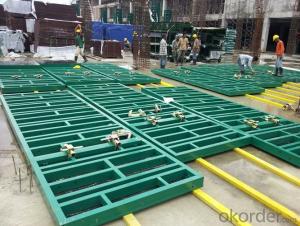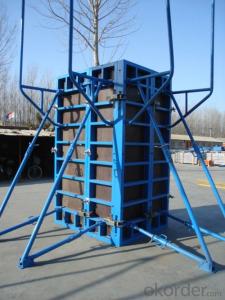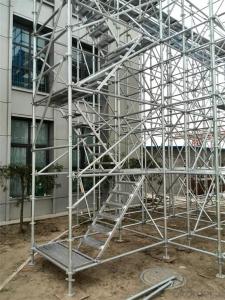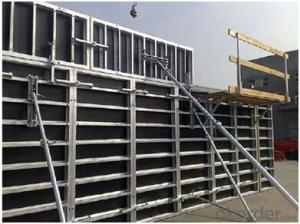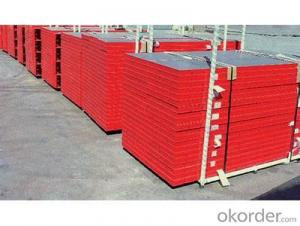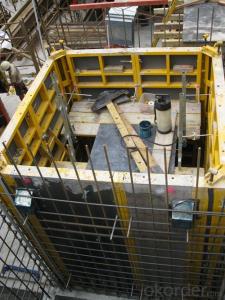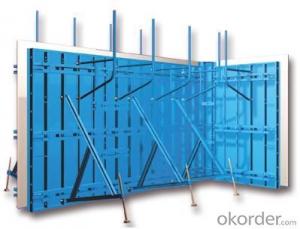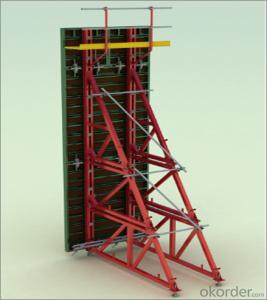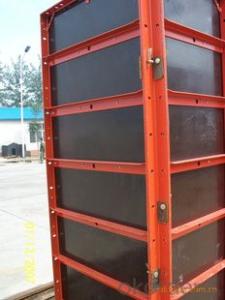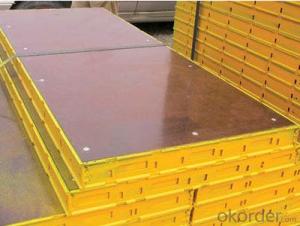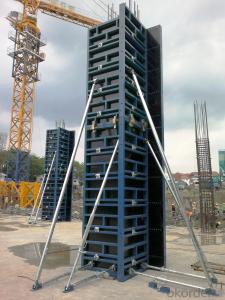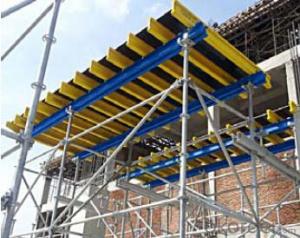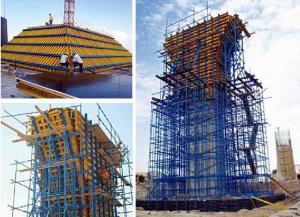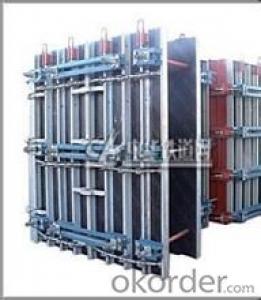Steel Fram Formworks Used in All Kinds of Construction
- Loading Port:
- Shanghai
- Payment Terms:
- TT OR LC
- Min Order Qty:
- 1 m²
- Supply Capability:
- 100000 m²/month
OKorder Service Pledge
OKorder Financial Service
You Might Also Like
1. Structure of Steel Frame Formwork GK120 Description
There is a prizing part designed in the corner, which can help to position and remove formwork easily.The plywood is screwed on from the back when connecting frame and plywood, so the surface of the finished concrete is perfect.The formwork series are a complete system with a full set of accessories, and can be set up flexibly according to project demand.
2. Main Features of Steel Frame Formwork GK120
-convenient for construction
-easy to control the quality
-easy, rapid and economical.
3. Steel Frame Formwork GK120 Images
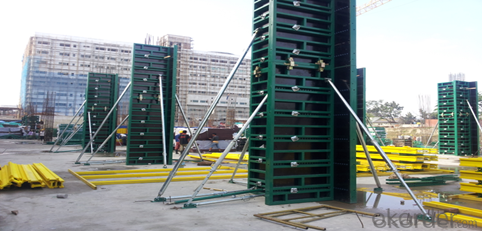
4. Steel Frame Formwork GK120Specifications
Steel Frame Formwork GK120 is used for the concrete pouring of square or rectangle column. The system has the same structure and similar connection type with wall formwork.
5.Steel Frame Formwork GK120
1) What can we do for you?
.We can ensure the quality of the Steel Frame Formwork GK120 and avoid extra expenses for customers.
.We can provide you the professional technical team.
.We can provide professional building proposal for your projects.
2) What promises can be done by us?
. If interested in this kind of formwork, please feel free to write us for any QUOTE.
. If need any technical and building assistance, we could provide on-site professional staff for instruction.
. Please DO check goods when courier knocks your door and contact us asap if any issueS.
3) What about of our after-sale services?
. Response will be carried out in 24hours after receiving any complain or request.
. Any formwork cost can be refund after order is confirmed.
. If the products are not based on the requirements, there will be the relevant compensations made for you.
4) What about the package and shipping time?
.Packing: wood package and adhesive tape
.Shipping: by sea
Shipping time: Normally small orders, it just1week business days to arrive your hand; When comes to the customs declaration, it may need 2weeks.
- Q: Can steel frame formwork be used in combination with architectural concrete finishes?
- Yes, steel frame formwork can be used in combination with architectural concrete finishes. The use of steel frame formwork provides a strong and stable structure that can withstand the pressure and weight of the concrete. Steel frame formwork is highly versatile and can be easily adjusted and modified to accommodate various architectural designs and shapes. Architectural concrete finishes, such as exposed aggregate, polished, or textured concrete, can be achieved by using steel formwork. The steel formwork allows for precise placement and shaping of the concrete, resulting in a smooth and aesthetically pleasing finish. Additionally, steel formwork can be reused multiple times, making it a cost-effective choice for projects that require architectural concrete finishes. However, it is important to ensure that the steel frame formwork is properly prepared before applying architectural concrete finishes. This may involve applying a release agent or using form liners to create desired textures or patterns. Proper formwork preparation and maintenance will help achieve the desired architectural concrete finish while preserving the integrity and durability of the steel formwork.
- Q: Can steel frame formwork be used for power plant structures?
- Yes, steel frame formwork can be used for power plant structures. Steel frame formwork is versatile and strong, making it suitable for various types of construction projects, including power plant structures. It provides stability and durability necessary for the construction of these large-scale industrial facilities.
- Q: Are there any restrictions on the formwork height that can be achieved with steel frame formwork in high-rise structures?
- Yes, there are restrictions on the formwork height that can be achieved with steel frame formwork in high-rise structures. The height of the formwork is limited by various factors such as the load-bearing capacity of the steel frame, the stability of the structure, and the ability to safely and efficiently pour and cure concrete at higher elevations. Additionally, the availability of adequate equipment and skilled labor for formwork installation and removal also plays a role in determining the maximum achievable formwork height in high-rise structures.
- Q: How does steel frame formwork contribute to the overall durability of a concrete structure?
- Steel frame formwork contributes to the overall durability of a concrete structure by providing a strong and rigid framework that ensures proper alignment and support during the pouring and setting of concrete. This formwork system helps in achieving accurate dimensions and preventing any deformation or cracking of the concrete. Additionally, the steel frame formwork is highly resistant to wear and tear, corrosion, and other environmental factors, thus enhancing the longevity and durability of the concrete structure.
- Q: Can steel frame formwork be used for curved or circular structures?
- Curved or circular structures can indeed be constructed using steel frame formwork. The flexibility of steel formwork allows for easy shaping to match the desired curve or shape of the structure. The steel frames can be modified and adjusted to achieve the desired form, guaranteeing accuracy and precision. This adaptability enables the construction of complex and unique curved or circular structures effortlessly. Furthermore, steel's strength and durability make it an excellent option for formwork, ensuring its ability to withstand the pressures and forces exerted during construction. In conclusion, steel frame formwork is a dependable and versatile solution for forming curved or circular structures.
- Q: How does steel frame formwork accommodate for different concrete mix designs?
- Steel frame formwork can accommodate for different concrete mix designs by allowing for easy adjustment of the formwork panels. This means that the size and shape of the formwork can be modified to accommodate variations in the concrete mix design, such as different slump levels or aggregate sizes. Additionally, the steel frame formwork provides stability and strength, ensuring that it can withstand the pressure exerted by different concrete mix designs during pouring and curing.
- Q: What are the considerations for selecting the appropriate thickness of steel frame formwork?
- When choosing the suitable thickness of steel frame formwork, there are several factors to take into account: 1. Load capacity: The steel frame formwork must be able to withstand the intended load, including the weight of the poured concrete and any additional loads like workers or equipment. It is crucial to calculate the maximum load and select a thickness that can safely support it. 2. Durability: The steel frame formwork should endure the construction environment, including exposure to weather elements, chemicals, and potential impacts or abrasions. Thicker steel frames generally offer more durability and resistance to wear and tear. 3. Span length: The thickness of the steel frame formwork should be suitable for the desired span length. Thin formwork may not be able to support the concrete weight over long spans, resulting in structural issues. Conversely, using excessively thick formwork for shorter spans may be unnecessary and add unnecessary weight and cost. 4. Construction schedule: The thickness of the steel frame formwork should also be considered in relation to the construction schedule. Thicker formwork may take longer to set up and dismantle, potentially slowing down the construction process. Striking a balance between the required strength and installation/removal efficiency is important. 5. Cost: The cost of the steel frame formwork is an important factor. Thicker formwork generally costs more due to the increased material required. It is crucial to evaluate the project budget and weigh the cost against the benefits of using thicker formwork. By carefully considering these factors, one can choose the appropriate thickness of steel frame formwork that fulfills the necessary load capacity, durability, span length, construction schedule, and cost considerations.
- Q: Can steel frame formwork be used for industrial structures?
- Yes, steel frame formwork can be used for industrial structures. Steel frame formwork is a versatile and durable system that offers numerous benefits for constructing industrial structures. Firstly, steel frame formwork provides excellent strength and rigidity, making it suitable for supporting heavy loads and withstanding the forces typically encountered in industrial construction. This makes it a reliable choice for constructing large-scale industrial buildings such as warehouses, factories, and power plants. Additionally, steel frame formwork offers a high level of customization and flexibility. It can be easily adjusted and modified to accommodate various shapes and sizes, allowing for the construction of complex industrial structures with different configurations. This adaptability is particularly important in industrial settings where unique designs and layouts may be required. Moreover, steel frame formwork is highly durable and long-lasting. It can withstand harsh environmental conditions, including extreme temperatures, moisture, and exposure to chemicals. This durability ensures that industrial structures built using steel frame formwork will have a longer lifespan and require less maintenance over time. Furthermore, steel frame formwork allows for efficient and rapid construction. Its modular nature and ease of assembly enable faster construction times, reducing overall project duration. This is crucial in industrial construction, where time is often a critical factor. Lastly, steel frame formwork can be easily dismantled and reused, making it a sustainable choice for industrial construction. By minimizing waste and promoting resource efficiency, steel frame formwork contributes to a more environmentally friendly construction process. In conclusion, steel frame formwork is a suitable choice for industrial structures due to its strength, customization options, durability, efficiency, and sustainability. It provides a reliable and cost-effective solution for constructing robust and versatile industrial buildings.
- Q: What is the maximum load capacity of steel frame formwork?
- The maximum load capacity of steel frame formwork depends on various factors such as the size and design of the formwork, the quality and strength of the steel used, and the support system in place. It is best to consult the manufacturer or structural engineer to determine the specific maximum load capacity for a particular steel frame formwork system.
- Q: How does steel frame formwork handle concrete shrinkage and expansion?
- To accommodate concrete shrinkage and expansion, steel frame formwork is engineered with the necessary flexibility and strength. It addresses shrinkage by utilizing adjustable mechanisms that allow for slight movements and adjustments in the formwork. These mechanisms, such as telescopic struts or adjustable props, can be easily modified to compensate for shrinkage and maintain the desired form and shape of the concrete structure. In contrast, concrete expansion can arise from factors like temperature changes or moisture absorption. Steel frame formwork is designed to withstand these expansion forces while upholding the structure's integrity. The steel frames are rigid and provide the essential strength and support to resist the expansion forces exerted by the concrete. Additionally, steel frame formwork can incorporate expansion joints, which serve as flexible connections between different sections of the formwork. These joints enable controlled movement and expansion of the concrete, reducing the risk of cracks or damage. In summary, steel frame formwork is purposefully constructed to handle concrete shrinkage and expansion by offering flexibility, adjustability, and strength. This ensures the stability and security of the formwork during the curing process, ultimately resulting in a structurally sound and long-lasting concrete structure.
Send your message to us
Steel Fram Formworks Used in All Kinds of Construction
- Loading Port:
- Shanghai
- Payment Terms:
- TT OR LC
- Min Order Qty:
- 1 m²
- Supply Capability:
- 100000 m²/month
OKorder Service Pledge
OKorder Financial Service
Similar products
Hot products
Hot Searches
Related keywords
